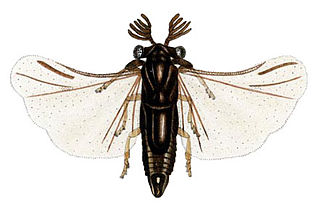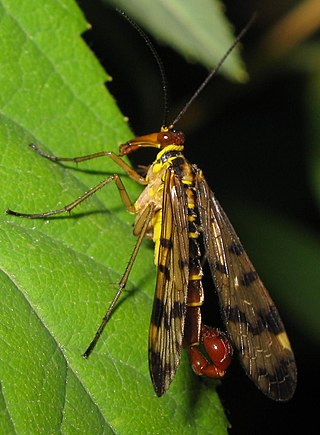
In biological cladistics for the classification of organisms, monophyly is the condition of a taxonomic grouping being a clade – that is, a grouping of taxa which meets these criteria:
- the grouping contains its own most recent common ancestor, i.e. excludes non-descendants of that common ancestor
- the grouping contains all the descendants of that common ancestor, without exception

The Strepsiptera are an order of insects with eleven extant families that include about 600 described species. They are endoparasites of other insects, such as bees, wasps, leafhoppers, silverfish, and cockroaches. Females of most species never emerge from the host after entering its body, finally dying inside it. The early-stage larvae do emerge because they must find an unoccupied living host, and the short-lived males must emerge to seek a receptive female in her host. They are believed to be most closely related to beetles, from which they diverged 300–350 million years ago, but do not appear in the fossil record until the mid-Cretaceous around 100 million years ago.

Flea, the common name for the order Siphonaptera, includes 2,500 species of small flightless insects that live as external parasites of mammals and birds. Fleas live by ingesting the blood of their hosts. Adult fleas grow to about 3 millimetres long, are usually brown, and have bodies that are "flattened" sideways or narrow, enabling them to move through their hosts' fur or feathers. They lack wings; their hind legs are extremely well adapted for jumping. Their claws keep them from being dislodged, and their mouthparts are adapted for piercing skin and sucking blood. They can leap 50 times their body length, a feat second only to jumps made by another group of insects, the superfamily of froghoppers. Flea larvae are worm-like, with no limbs; they have chewing mouthparts and feed on organic debris left on their hosts' skin.

The Pterygota are a subclass of insects that includes all winged insects and the orders that are secondarily wingless.

Holometabola, also known as Endopterygota, is a superorder of insects within the infraclass Neoptera that go through distinctive larval, pupal, and adult stages. They undergo a radical metamorphosis, with the larval and adult stages differing considerably in their structure and behaviour. This is called holometabolism, or complete metamorphism.

Mecoptera is an order of insects in the superorder Holometabola with about six hundred species in nine families worldwide. Mecopterans are sometimes called scorpionflies after their largest family, Panorpidae, in which the males have enlarged genitals raised over the body that look similar to the stingers of scorpions, and long beaklike rostra. The Bittacidae, or hangingflies, are another prominent family and are known for their elaborate mating rituals, in which females choose mates based on the quality of gift prey offered to them by the males. A smaller group is the snow scorpionflies, family Boreidae, adults of which are sometimes seen walking on snowfields. In contrast, the majority of species in the order inhabit moist environments in tropical locations.

The name Apterygota is sometimes applied to a former subclass of small, agile insects, distinguished from other insects by their lack of wings in the present and in their evolutionary history; notable examples are the silverfish, the firebrat, and the jumping bristletails. Their first known occurrence in the fossil record is during the Devonian period, 417–354 million years ago. The group Apterygota is not a clade; it is paraphyletic, and not recognized in modern classification schemes. As defined, the group contains two separate clades of wingless insects: Archaeognatha comprises jumping bristletails, while Zygentoma comprises silverfish and firebrats. The Zygentoma are in the clade Dicondylia with winged insects, a clade that includes all other insects, while Archaeognatha is sister to this lineage.

Pancrustacea is the clade that comprises all crustaceans, including hexapods. This grouping is contrary to the Atelocerata hypothesis, in which Hexapoda and Myriapoda are sister taxa, and Crustacea are only more distantly related. As of 2010, the Pancrustacea taxon was considered well accepted, with most studies recovering Hexapoda within Crustacea. The clade has also been called Tetraconata, referring to having four cone cells in the ommatidia. This name is preferred by some scientists as a means of avoiding confusion with the use of "pan-" to indicate a clade that includes a crown group and all of its stem group representatives.

Nannochoristidae is a family of scorpionflies with many unusual traits. It is a tiny, relict family with a single extant genus, Nannochorista, with eight species occurring in New Zealand, southeastern Australia, Tasmania, Argentina and Chile. Due to the group's distinctiveness from other scorpionflies, it is sometimes placed in its own order, the Nannomecoptera. Some studies have placed them as the closest living relatives of fleas. Most mecopteran larvae are eruciform, or shaped like caterpillars. Nannochoristid larvae, however, are elateriform, and have elongated and slender bodies. The larvae are aquatic, which is unique among mecopterans. The larvae are predatory, hunting on the beds of shallow streams, primarily on the larvae of aquatic Diptera like chironomids.

Boreidae, commonly called snow scorpionflies, or in the British Isles, snow fleas are a very small family of scorpionflies, containing only around 30 species, all of which are boreal or high-altitude species in the Northern Hemisphere.

The Panorpidae are a family of scorpionflies containing more than 480 species. The family is the largest family in Mecoptera, covering approximately 70% species of the order. Species range between 9–25 mm long.

The Empidoidea are a large monophyletic superfamily of true flies, the sister taxon to the Muscomorpha (Cyclorrhapha). These two groups are sometimes united in the unranked taxon Eremoneura. There are some 10,000 known species within Empidoidea, which are represented on all continents except Antarctica. They are known to have existed since the Jurassic period.

Amphiesmenoptera is an insect superorder, established by S. G. Kiriakoff, but often credited to Willi Hennig in his revision of insect taxonomy for two sister orders: Lepidoptera and Trichoptera (caddisflies). In 2017, a third fossil order was added to the group, the Tarachoptera.

The Neuropterida are a clade, sometimes placed at superorder level, of holometabolous insects with over 5,700 described species, containing the orders Neuroptera, Megaloptera, and Raphidioptera (snakeflies).
Neolepidoptera is a clade within Myoglossata in suborder Glossata of order Lepidoptera, the butterflies and moths. They differ from other Myoglossata in the larval stage abdominal prolegs, pupal morphology, and the mandibles are reduced in area. They also differ in their reproductive systems. The prolegs have muscles and apical hooklets. The reproductive organs have two openings. There are also differences in the wing structure. The pupae are "incomplete or obtect."

Paraneoptera or Acercaria is a superorder of insects which includes lice, thrips, and hemipterans, the true bugs. It also includes the extinct order Permopsocida, known from fossils dating from the Early Permian to the mid-Cretaceous.

The subphylum Hexapoda or hexapods comprises the largest clade of arthropods and includes most of the extant arthropod species. It includes the crown group class Insecta, as well as the much smaller class Entognatha, which includes three orders of wingless arthropods that were once considered insects: Collembola (springtails), Protura (coneheads) and Diplura. The insects and springtails are very abundant and are some of the most important pollinators, basal consumers, scavengers/detritivores and micropredators in terrestrial environments.

Eumetabola is an unranked clade of Neoptera. Two large unities known as the Eumetabola and Paurometabola are probably from the adelphotaxa of the Neoptera after exclusion of the Plecoptera. The monophyly of these unities appears to be weakly justified.

Aspidytidae is a family of aquatic beetles of the suborder Adephaga, described in 2002 from specimens in South Africa and China. There are only two known species in the family and these were originally described in the genus Aspidytes, but later the new genus Sinaspidytes was erected for the species found in China. The family can also be referred to by its trivial name cliff water beetles.

Hymenopterida is a superorder of holometabolous (metamorphosing) insects. As originally circumscribed, it included Hymenoptera and the orders in Panorpida. However, more recent studies find Hympenoptera as sister to the other members of Holometabola and the superorder is restricted to Hymenoptera.























